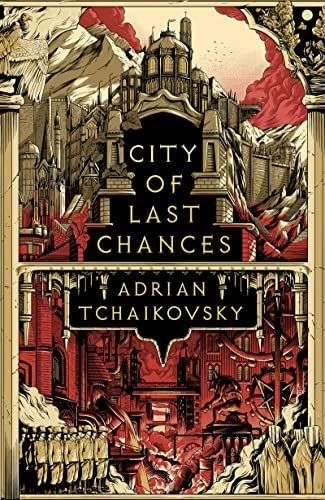We’ve implemented some new protocols around sending us messages via this website. Please email website “at” britishfantasysociety “dot” org for any issues.

For all things fantasy, horror, and speculative fiction
-
Announcement:

Available for Preorder – City of Last Chances by Adrian Tchaikovsky from @HoZ_Books
City of Last Chances by Adrian Tchaikovsky
Head of Zeus, hb, £16.05
Reviewed by Sarah Deeming

Ilmar sits on the edge of the Anchorwood, a grove of trees that leads to other places. To freedom. Although Ilmar is under Palleseen occupation, refugees, wanderers, and fortune seekers all travel to the city looking to escape through Anchorwood to a fresh start.
The Palleseen are also interested in Anchorwood because they cannot abide chaos. They want to control Anchorwood’s magical ways and bring them to order. When the Palleseen emissary to Anchorwood is killed, the Palleseen punish Ilmar’s inhabitants, igniting a spark of rebellion in them that threatens to burn the whole city.
City of Last Chances is a high fantasy novel with a huge cast of characters, and the story focuses on those who play an integral part in the growing discord and eventual rebellion. The opening chapters introduce these characters in a natural way, showing us how the city moves like a river with eddies and swirls. We meet most of the main characters at an illegal gambling table which is disturbed, and they scatter when the Palleseen emissary is killed. In that scattering, other connections are made, showing Ilmar like a spiderweb with Anchorage, the inn at the edge of Anchorwood in the centre. Actions in one location cause ripples throughout the city, and the implication is that if everyone worked together, the Palleseen wouldn’t stand a chance.
But nothing is ever that simple where people are concerned. Although many factions want Ilmar’s liberation, most of them are wealthier dealing on the black market because of the occupation than if they were free. The difference between ideals and pragmatism is played out in dingy back alley rooms and bars, with the students of Gownhall waving banners and singing songs while the Bitter Sisters get rich on smuggling weapons that will never be used. The sheer scope of the politics of play is world-building at its best, with so many different elements all vying for position while not drawing too much attention to themselves.
My favourite character is Maestro Ivarn Ostravar, a lecturer at Gownhall. He thinks he is the most intelligent person in the city, keeping company with both sides, giving just enough information to be useful, and, therefore, safe from Palleseen punishment. But to his students, he preaches lofty ideals, and they believe that if the revolution came, Ostravar would be at the front. Over the book’s course, Ostravar has all his delusions stripped as he discovers he is neither as intelligent nor essential as he’d thought and his favourite student, Lemya, sees her hero for the petty, selfish man he is. It was a satisfying story arc.
Despite the book’s cleverness, I couldn’t quite connect with it in the way I wanted to because I felt the book was too small for its concepts. Ilmar has native factions at war with each other and the Palleseen. There are refugee magicians, once the most powerful in their land, now barely tolerated in Ilmar. Part of the city is infected with madness that consumes anyone who stays there too long. There are huge factories powered by demons supplied by a contract between the refugee magicians and the demon king. And the Indwellers, Anchorwood’s inhabitants, are on the edge of everything in the world but not of the world. Students talk of change and sing songs, and think their actions will make a difference in the political landscape. All of it is current to the world we’re living in, yet it strained at the confines of one book, and I didn’t get enough information to really invest.
But City of Last Chances is a powerful story about romanticism versus the truth of rebellion, the sacrifice, blood and tears instead of chanting slogans and singing. It resonates with the world we live in today and is well worth investing your time in more than once, as I feel a second read would enhance my understanding and enjoyment. Highly recommended.
Explore the blog:
Blog categories:
Latest Posts:
Tags:
#featured (56) #science fiction (25) Book Review (264) events (44) Fantasy (231) Graphic Novel (13) horror (136) Members (62) Orbit Books (48) profile (43) Romance (17) Science Fiction (50) short stories (28) Titan Books (52) TV Review (15)
All reviews
Latest Reviews:
- THE HOUSE ON THE BORDERLAND by William Hope Hodgson
- Monstrum by Lottie Mills
- Mood Swings by Dave Jeffery
- Yoke of Stars by R.B. Lemberg
- Hera by Jennifer Saint
- The Black Bird Oracle by Deborah Harkness
- RETURN OF THE DWARVES By Markus Heitz
- Delicious in Dungeon
- Toxxic by Jane Hennigan
- THIS ISLAND EARTH: 8 FEATURES FROM THE DRIVE-IN By Dale Bailey
Review tags:
#featured (2) Action (4) Adventure (4) Book Review (28) Fantasy (18) Featured (2) Feminist (2) Gothic Horror (3) Horror (14) Magic (3) Orbit Books (3) Romance (6) Science Fiction (5) Swords and Sorcery (2) Titan Books (7)